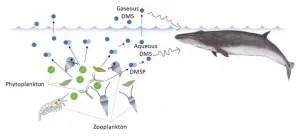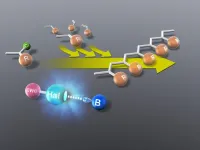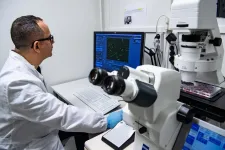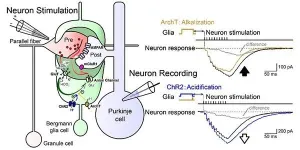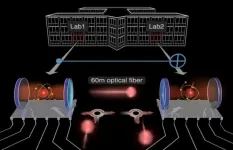(Press-News.org) A joint research project between organizations in Japan and the US has demonstrated that zooplankton, a major food source for marine predators, can be located by following the concentration gradient of the chemical dimethyl sulfide (DMS) in ocean water and air. Currently, little is known about how marine predators search for and find enough food to maintain their body size. This study is expected to expand research into the chemical triggers of marine organisms while foraging.
Zooplankton, such as krill and copepods are the main energy source for many large marine animals. The big predators must consume a large amount of these tiny creatures to provide enough energy to power their enormous bodies. How they find their food is still not clearly understood.
Krill feed on phytoplankton which produce and retain water-soluble compounds in their bodies to cope with osmotic pressure. This is essential for survival in seawater. One of these compounds is dimethylsulfoniopropionate (DMSP). DMSP contains sulfur elements and is zwitterionic, meaning that it has both a positive and a negative charge like an amino acid. It is broken down by bacteria into DMS, a component of the familiar aromas associated with ocean air or dried seaweed. DMSP stored in phytoplankton is released into seawater when zooplankton graze on the phytoplankton, which is hypothesized to result in higher DMS concentrations in dense zooplankton areas. It is thought that marine predators could use DMS concentration to locate food sources. While attraction to artificially released DMS has been shown in some predatory species, whether natural gradients of DMS are used by predators and serve as a useful foraging cue remains unknown.
To investigate the phenomenon, an international team of researchers from END
Follow the smell of the ocean to find where marine predators feed
2021-02-24
ELSE PRESS RELEASES FROM THIS DATE:
Southern California COVID-19 strain rapidly expands global reach
2021-02-24
LOS ANGELES (Feb. 11, 2021) -- A new strain of the coronavirus in Southern California, first reported last month by Cedars-Sinai, is rapidly spreading across the country and around the world as travelers apparently carry the virus with them to a growing list of global destinations, according to new research published today in the peer-reviewed Journal of the American Medical Association (JAMA).
The strain, known as CAL.20C, was first observed in July 2020 in a single Los Angeles County case, as Cedars-Sinai earlier reported. It reemerged in October in Southern California and then quickly END ...
Fabricating the future with a new environment friendly method of polymerization
2021-02-24
Many materials in the modern world--from the plastics that dominate it to the electronic chips that drive it--are constructed of polymers. Given their ubiquity and the evolving requirements of our world, finding better and more efficient methods of making them is an ongoing research concern. In addition, current environmental issues necessitate the use of methods and input materials that are environment friendly.
Recent research by scientists from Nagoya Institute of Technology, Japan, has been in this vein, adding a new twist to a polymerization technique that has been around and successful since the 1980s: living cationic polymerization, where the polymer chain growth does not have the ability to terminate until the monomer is consumed. The scientists have, for the first ...
New fossil discovery illuminates the lives of the earliest primates
2021-02-24
New York, February 24, 2021 - Graduate Center, CUNY/Brooklyn College professor was part of a discovery of the first fossil evidence of any primate, illustrating the earliest steps of primates 66 million years ago following the mass extinction that wiped out all dinosaurs and led to the rise of mammals.
Stephen Chester, an assistant professor of anthropology and paleontologist at the Graduate Center, CUNY and Brooklyn College, was part of a team of 10 researchers from across the United States who analyzed several fossils of Purgatorius, the oldest genus in a group of the earliest-known primates called plesiadapiforms. ...
Many genes associated with the risk of coronary artery disease act through the liver
2021-02-24
According to a new study published in The American Journal of Human Genetics, more than one third of genetic variants that increase the risk of coronary artery disease regulate the expression of genes in the liver. These variants have an impact on the expression of genes regulating cholesterol metabolism, among other things. The findings provide valuable new insight into the genetics of coronary artery disease. The study was conducted in collaboration between the University of Eastern Finland, Kuopio University Hospital, the University of California Los Angeles, and the University of Arizona.
Coronary artery disease (CAD) and its most important complication ...
DV survivor elder abuse risk
2021-02-24
Australian researchers have called for additional services for survivors of intimate partner violence - warning those who have these experiences are more vulnerable to elder abuse.
Women who survive domestic violence continue to experience negative effects well into their older years but they are also more vulnerable to elder abuse, says Flinders University researcher Dr Monica Cations, lead author of the study published in the American Journal of Geriatric Psychiatry.
"This is the first time this relationship has been demonstrated and tells us that older survivors need close monitoring and prevention efforts to keep them safe from further abuse."
The study looked at the psychological and physical impacts and risk for elder abuse associated ...
Exposure to superbacteria among visitors to the tropics proved more extensive than thought
2021-02-24
Before the corona pandemic, tens of millions international travellers annually headed to the tropics, getting exposed to local intestinal bacteria. A total of 20-70% of those returning from the tropics carry - for the most unknowingly - ESBL-producing bacteria resistant to multiple antibiotics. The likelihood of acquiring such superbacteria depends on destination and health behaviour abroad. The risk is greatest in South and Southeast Asia, and a substantial increase is associated with contracting travellers' diarrhoea and taking antibiotics while abroad.
An investigation led by professor ...
Signal coupling between neuron-glia super-network may lead to improved memory formation
2021-02-24
Tohoku University scientists have shown that neuronal and glial circuits form a loosely coupled super-network within the brain. Activation of the metabotropic glutamate receptors in neurons was shown to be largely influenced by the state of the glial cells. Therefore, artificial control of the glial state could potentially be used to enhance the memory function of the brain.
The findings were detailed in the Journal of Physiology.
Although the glial cells occupy more than half of the brain, they were thought to act as glue--merely filling the gap between neurons. However, recent findings show that the concentration of intracellular ions in glia, ...
New study suggests supermassive black holes could form from dark matter
2021-02-24
A new theoretical study has proposed a novel mechanism for the creation of supermassive black holes from dark matter. The international team find that rather than the conventional formation scenarios involving 'normal' matter, supermassive black holes could instead form directly from dark matter in high density regions in the centres of galaxies. The result has key implications for cosmology in the early Universe, and is published in Monthly Notices of the Royal Astronomical Society.
Exactly how supermassive black holes initially formed is one of the biggest problems in the study of galaxy evolution ...
World's first video of a space-time crystal
2021-02-24
A German-Polish research team has succeeded in creating a micrometer-sized space-time crystal consisting of magnons at room temperature. With the help of the scanning transmission X-ray microscope Maxymus at Bessy II at Helmholtz Zentrum Berlin, they were able to film the recurring periodic magnetization structure in a crystal. Published in the Physical Review Letters, the research project was a collaboration between scientists from the Max Planck Institute for Intelligent Systems in Stuttgart, Germany, the Adam Mickiewicz University and the Polish Academy of Sciences in Pozna? in Poland.
Order in space and a periodicity in time
A crystal is a solid whose atoms or molecules are regularly arranged in a particular structure. If one looks at the arrangement with a microscope, one discovers ...
Quantum systems learn joint computing
2021-02-24
Today's quantum computers contain up to several dozen memory and processing units, the so-called qubits. Severin Daiss, Stefan Langenfeld, and colleagues from the Max Planck Institute of Quantum Optics in Garching have successfully interconnected two such qubits located in different labs to a distributed quantum computer by linking the qubits with a 60-meter-long optical fiber. Over such a distance they realized a quantum-logic gate - the basic building block of a quantum computer. It makes the system the worldwide first prototype of a distributed quantum computer.
The limitations of previous qubit architectures
Quantum ...
